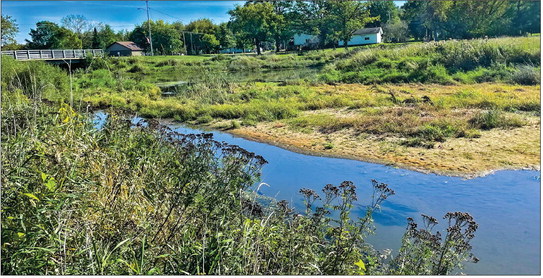Scotch Creek plans moving forward


By Kevin O’Brien
Edgar native Gordon Krall shared his vision for reviving Scotch Creek with the village’s parks commission last week, explaining how a variety of funding sources could be used to develop and implement a plan for rehabilitating the impaired waterway and the surrounding wetlands.
Speaking to commissioners remotely from his home in California, Krall detailed all the steps he has already taken to apply for a DNR grant and seek support from various organizations devoted to restoring wildlife habitat and cleaning up bodies of water.
Earlier in September, the village board adopted a resolution in support of Krall’s grant application to the Wisconsin DNR’s Surface Water Grant program, which could provide up to $47,850 for an engineering firm to write a comprehensive management plan for the creek.
In his grant application, Krall said “the health and the flow of the creek is severely encumbered,” and it is also prone to flooding, which increases shoreline erosion that pulls more phosphorus into the water. The level of phosphorus in the creek already exceeds safe levels, and it continues to receive more stormwater runoff due to residential and commercial growth within the village, he noted.
“The routing and effect of this increased storm water to the health of Scotch Creek must be understood and mitigated before any adverse effects are feasibly irreversible,” he wrote. At the same time, Krall noted in the application that the village has recently completed a multi-year upgrade of its wastewater treatment facilities, installing “stateof- the-art” technology that has decreased
See SCOTCH CREEK/ page 12
HELP ON THE WAY - Scotch Creek, which runs through the center of Edgar, is the target of a restoration effort started by Edgar native Gordon Krall, who is working with the village to raise money for a management plan. STAFF PHOTO/KEVIN O’BRIEN Scotch Creek
Continued from page 1
phosphorus discharge levels “far below regulatory requirements.”
“There is no concern for lack of community support, as the degradation of Scotch Creek is well spoken about,” Krall wrote in the grant application, adding that “attempts to affect change have never got off the ground in the past, due primarily to lack of knowledge of what the multi-faceted solution is and how to legally get it done.”
Krall first spoke to the village board about his plans in August, a few months after purchasing seven acres of undeveloped land along Scotch Creek from River Country Coop, just west of Scotch Creek park and south of Redwood Street.
At last week’s parks commission meeting, Krall said he has made initial contact with two engineering firms, Cooper Engineering and EOR (Emmons & Olivier Resources), which are developing proposals and price quotes for drafting a management plan. He estimated the cost for a management plan to be between $50,000 and $65,000.
In recent weeks, Krall said he has also reached out to various non-profits for support, including Ducks Unlimited, which reviewed his plans but declined to get involved because the project is considered “too small” for the group. However, he said the group representative he spoke to was impressed with his proposal and confirmed that he was working in the right direction.
“That was really good validation that what we’ve done to date is the right thing,” he said.
Krall is also applying for a grant through the North American Wetlands Conservation Act (NAWCA), a federal program dedicated to restoring wetland habitats for migratory birds. A wetland delineator, Kristi Sherfinski, has developed special maps needed to complete the application, which is due Oct. 15. Around $250,000 in funding is available, he said.
In conjunction with that grant application, the village has posted a five-question survey on its website asking people to identify what kinds of waterfowl and others birds they have seen around Scotch Creek and rank the overall diversity of birds in the watershed.
The Edgar native is also seeking corporate grants from various companies, including $313,000 from S.E. Johnson, $25,000 from Burlington Northern Santa Fe, and $100,000 from Exxon Mobile. All of these applications were submitted at the end of September for possible funding in 2025.
“Does that mean we’re going to get any of them? Who knows?” he told park commissioners. “But, I tell you what, with your collaboration, we’re writing up some very good grant applications.”
Krall said he has already obtained a DNR permit to do work on his seven acres of land, so that the area is “shovel-ready” once funding becomes available. He said an important next step is to obtain a conservation easement, which will require approval by the village board.
The proposal has also received a letter of support from the Wisconsin Conservation Club, and Krall said he’s hoping for a letter from the Aldo Leopold Audubon Society, which would potentially pay for migratory bird surveys as part of the project. Golden Sands Resource Conservation & Development has already committed to doing studies on invertebrates in the stream, he said.
Pheasants Forever and the Wisconsin Trappers Association have signaled their possible interest in the project, with the association willing to do a habitat survey for beavers and other wildlife and also educating the public on responsible trapping activities, he said.
Once the management plan is in place – with recommendations on how to remove impairments from the creek – Krall said the village will have full discretion on what it wants to implement and how much money it’s willing to spend.
“If we don’t get corporate sponsorship for any of this, or for a certain amount of it, what is the amount of municipal funding that we’ve got to budget for that activity?” he said. “Usually it’s a one-to-one match for whatever the grant funding is.”
When one of the commissioners asked Krall for examples of similar projects that have been successful, Krall cited a project focused on the Little Plover River in the village of Plover and the ongoing Fenwood Creek Watershed project led by Marathon County.
Krall was also asked about the possible problems with attracting waterfowl like Canadian geese, which tend to create a mess wherever they congregate. In response, Krall said the village can always plant certain vegetation to support the kind of wildlife it wants to attract.
At the same time, however, he said the environmental engineers who develop the management plan are going to consider the longterm history of the creek, going back 50 to 70 years, with an eye toward restoring the waterway to its natural condition. He expects the recommendations to call for making the creek narrower and shallower, rather than dredging it deeper to recreate a swimming hole people remember from the 1980s.
“I think we should be cautious about what we expect,” he said.
Although he advised the park commission to expect some “disappointments” along the way when it comes to funding and implementing the restoration project, Krall said overall he is very optimistic.
“It’s resonating really well with all of the non-profits that are working on it,” he said. “It’s resonating really well with the other corporations and their sustainability plans.”
Other business
■ The commission approved an updated Comprehensive Outdoor Recreation Plan for 2024-2028, which spells out what the village has done in the past five years to improve local parks and recreations and sets goals for future plans. Village administrator Jennifer Lopez said the updated plan needs to be in place in order for the village to qualify for grants.
■ Commissioners discussed plans for a new concession stand and storage building at the Oak Street Ball Park, and voted to continue the planning process. Lopez said the village could hire an architect to draft a floor plan, but then it would have to solicit bids for construction.
■ The commission held off on approving the purchase of new playground equipment, at a cost of $31,692 from Swing Kingdom, for Oak Street Ball Park. One of the ideas that came out of the discussion was to move the playground to the east so it is less likely to be hit with foul balls. Installing the new equipment won’t happen until next spring, so commissioners decided not to take action at this point.
“It doesn’t pay to make fast decisions if we’ve got the time,” said commission president Rick Mueller.
■ Trustee Cathy Schueller told the commission that the Edgar Lions Club plans on putting up Christmas lights at Oak Street, starting at 9 a.m. on Saturday, Oct 26, with the goal of lighting up the park on or near Thanksgiving like they did last year.



